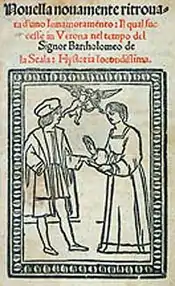Luigi Da Porto
Luigi Da Porto (1485 in Vicenza – 10 May 1529) was an Italian writer and storiographer, better known as the author of the novel Novella novamente ritrovata with the story of Romeo and Juliet, later reprised by William Shakespeare for his famous drama.[1]


Da Porto wrote the novel in his villa in Montorso Vicentino[2][3] near Vicenza before June 1524, and dedicated it to his cousin Lucina Savorgnan. The novel was published posthumously and anonymously about 1531 in Venice with the title Historia novellamente ritrovata di due nobili amanti ("Newly found story of two noble lovers").[4] The origin of the story of the two unlucky lovers is disputed; however, Da Porto probably took the inspiration from a tale by Masuccio Salernitano called Mariotto e Ganozza, introducing many modern elements reprised by Shakespeare's drama.
.JPG.webp)
Some inspiration may have stemmed from da Porto's own experiences: on 26 February 1511, the day before the Cruel Fat Thursday in Udine, he apparently fell in love with the sixteen-year-old (or older) Lucina Savorgnan, who enchanted a ball with her singing. However, at the time, the conflicts between and within Friulian clans were at a critical point. Da Porto was very close to his uncle Antonio Savorgnan but unfortunately, Antonio's relationship with Lucina's guardian Girolamo Savorgnan was at a nadir.[5] Years later, badly wounded and paralyzed from his battles, Luigi wrote the novella in his villa. Although the setting of the story is Verona, the inspiration for the idea of two warring families came from the two castles of Montecchio Maggiore, which he could see from his window in his villa.[2][3] He dedicated the work to Lucina, who by then had become married to Francesco Savorgnan, another of Antonio's nephews.[6]
Da Porto set the story in Verona (at that time, a strategic city for Venice), during the signoria of Bartolomeo I della Scala (1301–1304), but from some detail, the urban structure resembles more that of Udine.[7] He created the names of Romeo (later Romeus) and Giulietta (soon to be Juliet in England) and even created the characters of Mercutio, Tybalt, Friar Laurence and Paris.
References
- Peter Brand, Lino Pertile (1996). The Cambridge History of Italian Literature. Cambridge University Press. p. 227. ISBN 0-521-43492-0.
- "The Mystery of Villa L. Da Porto in Montorso Vicentino". Italy by US. 2018-07-09. Retrieved 2023-02-15.
- "L'orgoglio storico e Luigi Da Porto «Giulietta è nostra»" [The historical pride and Luigi Da Porto "Giulietta is ours"]. Corriere del Veneto (Vicenza e Bassano). 2018-02-01. Retrieved 2023-02-15 – via PressReader.com.
il primo a scrivere la novella di Giulietta e Romeo fu il vicentino Luigi Da Porto, che dalla villa di Montorso fu ispirato - si narra - dai due castelli di Montecchio Maggiore. [the first to write the novella of Juliet and Romeo was the Vicenza Luigi Da Porto, who from the villa of Montorso was inspired - it is said - by the two castles of Montecchio Maggiore.]
- Prunster, Nicole (2000). Romeo and Juliet Before Shakespeare: Four Early Stories of Star-crossed Love. Toronto: Centre for Reformation and Renaissance Studies. pp. 2–3. ISBN 0772720150.
- Clough, Cecil H.; Hale, John R.; Chambers, David; Mallett, Michael (1993). Love and war in the Veneto: Luigi da Porto and the True Story of Giulietta e Romeo. pp. 99–128. ISBN 1852850906.
{{cite book}}:|work=ignored (help) - Muir, Edward (1998). Mad Blood Stirring: Vendetta and Factions in Friuli During the Renaissance. Johns Hopkins University Press. pp. 86–89. ISBN 0801858496.
- Comelli, Albino; Tesei, Francesca (2012). Giulietta e Romeo: l'origine friulana del mito. Scandicci: L’Autore Libri Firenze. ISBN 978-88-517-2544-0.
External links
- O'Connell, Ronan (2023-02-14). "Shakespeare didn't create Romeo and Juliet? On the trail of the romantic story's true author in northern Italy". South China Morning Post. Retrieved 2023-02-14.